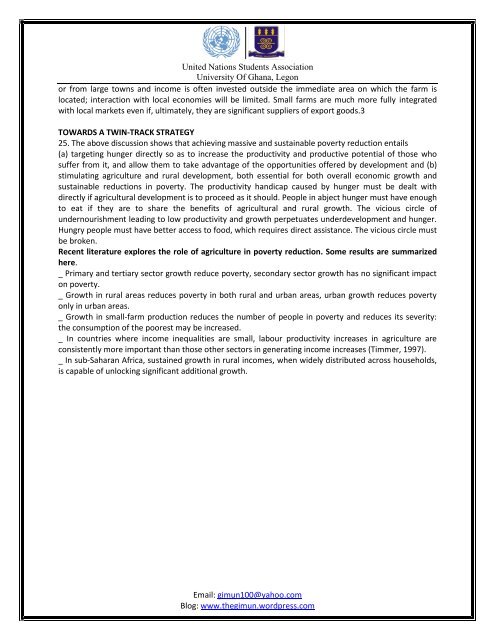United Nations Students Association University Of Ghana, Legon ...
United Nations Students Association University Of Ghana, Legon ...
United Nations Students Association University Of Ghana, Legon ...
You also want an ePaper? Increase the reach of your titles
YUMPU automatically turns print PDFs into web optimized ePapers that Google loves.
<strong>United</strong> <strong>Nations</strong> <strong>Students</strong> <strong>Association</strong><br />
<strong>University</strong> <strong>Of</strong> <strong>Ghana</strong>, <strong>Legon</strong><br />
or from large towns and income is often invested outside the immediate area on which the farm is<br />
located; interaction with local economies will be limited. Small farms are much more fully integrated<br />
with local markets even if, ultimately, they are significant suppliers of export goods.3<br />
TOWARDS A TWIN-TRACK STRATEGY<br />
25. The above discussion shows that achieving massive and sustainable poverty reduction entails<br />
(a) targeting hunger directly so as to increase the productivity and productive potential of those who<br />
suffer from it, and allow them to take advantage of the opportunities offered by development and (b)<br />
stimulating agriculture and rural development, both essential for both overall economic growth and<br />
sustainable reductions in poverty. The productivity handicap caused by hunger must be dealt with<br />
directly if agricultural development is to proceed as it should. People in abject hunger must have enough<br />
to eat if they are to share the benefits of agricultural and rural growth. The vicious circle of<br />
undernourishment leading to low productivity and growth perpetuates underdevelopment and hunger.<br />
Hungry people must have better access to food, which requires direct assistance. The vicious circle must<br />
be broken.<br />
Recent literature explores the role of agriculture in poverty reduction. Some results are summarized<br />
here.<br />
_ Primary and tertiary sector growth reduce poverty, secondary sector growth has no significant impact<br />
on poverty.<br />
_ Growth in rural areas reduces poverty in both rural and urban areas, urban growth reduces poverty<br />
only in urban areas.<br />
_ Growth in small-farm production reduces the number of people in poverty and reduces its severity:<br />
the consumption of the poorest may be increased.<br />
_ In countries where income inequalities are small, labour productivity increases in agriculture are<br />
consistently more important than those other sectors in generating income increases (Timmer, 1997).<br />
_ In sub-Saharan Africa, sustained growth in rural incomes, when widely distributed across households,<br />
is capable of unlocking significant additional growth.<br />
Email: gimun100@yahoo.com<br />
Blog: www.thegimun.wordpress.com


